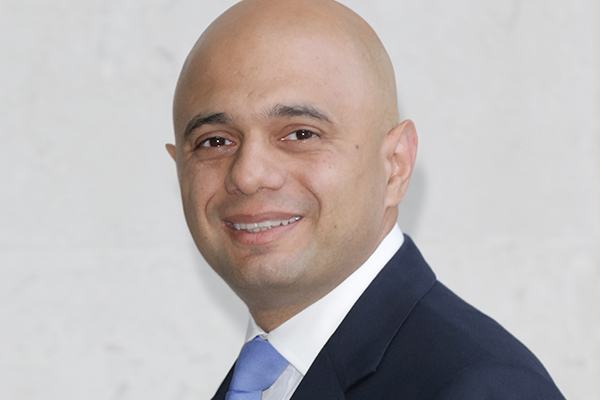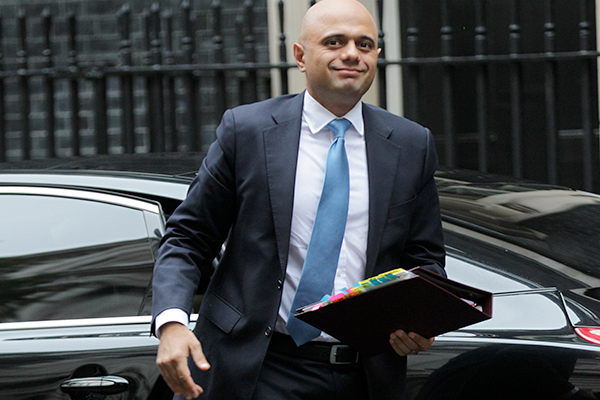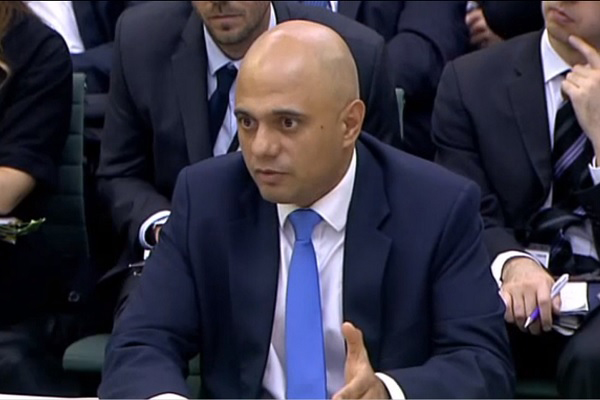You are viewing 1 of your 1 free articles
Javid’s NHF conference speech in full
Communities secretary Sajid Javid this morning announced a green paper for social housing. Read the full text of his speech to the National Housing Federation conference in Birmingham below
“Thank you, David [Orr, chief executive, National Housing Federation], and good morning everyone.
It’s great to be here in Birmingham and a real honour to be opening your conference this year.
And it’s good to see so many of you here at what is a particularly important and, as we’ve just heard, particularly challenging time for this country’s housing associations.
I know, of course, you’ve got a lot on your minds.
I’ve certainly got a lot on mine and I’m looking forward to sharing that with you.
But before all that, as an almost-local member of parliament I have to give you a quick West Midlands history lesson!
Here at the ICC we’re literally just over the road from the site of the first major Cadbury factory, which opened its doors in 1847.
It’s not there anymore, sadly.
But if you pop out at lunchtime you can still see the little canal spur that served the rapidly growing business.
It’s right there behind the giant hotel and the Australian-themed pub!
I’m fairly sure neither of them were there at that time!
And that wasn’t the only difference.
Back in the 1800s, the area wasn’t the clean, fresh, welcoming place that you all saw this morning.
Quite the opposite.
And that’s why after nearly 30 years here on Bridge Street, the Cadbury brothers upped sticks and they moved operations five miles south to what was then a bucolic rural idyll that sat just outside the city.
They moved there because, yes, they needed a bigger, more appropriate site.
But they also wanted a better place for their workers and their families to make their homes.
As George Cadbury said at the time, “no man ought to be condemned to live in a place where a rose cannot grow”.
The Cadburys recognised that our homes aren’t just places where we sleep and eat.
They aren’t just machines for living in.
Machines don’t have souls and hearts, but homes do.
They shape who we are.
They reflect our lives, our choices, our personalities.
And our homes can limit us, too.
Living in the wrong kind of house or the wrong kind of place can close off avenues and opportunities, and of course can affect your life chances.
A child who can’t find a quiet place to study may struggle to make progress at school.
An adult who is unable to relocate may miss out on a life-changing promotion at work.
And, of course, you’re also judged on where you live.
On what kind of house you live in.
Which side of the tracks you came from.
I grew up on Stapleton Road in Bristol – also known as “Britain’s most dangerous street” or a “moral cesspit”, depending on your tabloid of choice.
And I remember my school careers advisor telling me that there was no point in aiming high because kids from my neck of the woods simply didn’t take A-levels or go to university.
Society had low expectations of us, and we were expected to live down to them.
It was the same years later, when I was applying for jobs with merchant banks in London.
I got the sense that the interview panels had never before met someone who lived in the overcrowded flat above the family shop.
That’s just my experience. It’s just one person’s story.
But if the Grenfell tragedy showed us anything, it was the extent to which these attitudes have spread and become deeply ingrained in the way this country thinks and it acts.
While I don’t want to pre-judge the findings of the public or police inquiries, it’s clear that in the months and the years before the fire, the residents of Grenfell Tower were not listened to.
That their concerns were ignored or dismissed.
That too many people in positions of power saw tenants less as people with families and more as problems that needed to be managed.
A lot has been written and said about the social and political context of Grenfell.
Much of it accurate, some of it less so.
There’s certainly been some unfair criticism of social landlords generally.
Unfair because I know that everyone in this room is passionate about what they do.
Passionate about getting safe, secure, affordable roofs over the heads of families.
I know that and you know that.
And I want to thank you all, and everyone that you employ, for all the good that you do. Thank you very much.
But the question I keep coming back to is very simple.
In one of the richest, most privileged corners of the UK – the world, even – would a fire like this have happened in a privately owned block of luxury flats?
If you believe that the answer is no, even if you think it was simply less likely, then it’s clear that we need a fundamental rethink of social housing in this country.
Because whether they’re owned by a council or by a housing association, whether they’re managed by a TMO or a local authority, we’re not just talking about bricks and mortar.
We’re not just talking about assets on your balance sheet.
We’re talking about people’s homes.
About people’s lives.
Over the past few weeks the housing minister, Alok Sharma, has been meeting with social housing tenants right across the country.
And from those conversations it’s already clear that they want us to look again at the quality and safety of what’s on offer.
To look again at the way tenants are listened to and their concerns acted on.
To look again at the number of homes being built, at community cohesion and more besides.
And that’s exactly what this government is going to do.
Today I can announce that we will be bringing forward a green paper on social housing in England.
A wide-ranging, top-to-bottom review of the issues facing the sector, the green paper will be the most substantial report of its kind for a generation.
It will kick off a nationwide conversation on social housing.
What works and what doesn’t work.
What has gone right and what has gone wrong.
Why things have gone wrong and – most importantly – how to fix them.
And the results will help everyone involved in the whole world of social housing: local and central government, housing associations, TMOs, and of course the tenants themselves, to make this country’s social housing provision something the whole nation can be proud of.
Of course, in the wake of Grenfell, the green paper will look at safety issues.
But it will need to go much further.
It will look at the overall quality of social homes, many of which are now beginning to show their age.
It will cover service management, the way social homes and their tenants are taken care of.
It will look at the rights of tenants and show how their voices can be better heard.
And it will cover what can be done to ensure their complaints are taken seriously and dealt with properly, and make sure tenants have clear, timely avenues to seek redress when things do go wrong.
If a resident reports a crack in the wall that you can fit your hand in, big enough to use as a book shelf, it shouldn’t just be patched up and ignored.
The reason it’s there and the impact it could have need to be properly investigated.
Problems shouldn’t just be fixed, they should be learned from.
These are the kind of issues the green paper will explore.
But that’s not all. It will also look at wider issues of place, community, and the local economy.
How can social landlords help to create places that people really want to live in, places where roses can grow?
What role can social housing policy play in building safe and integrated communities, where people from different backgrounds get along no matter what type of housing they live in?
How do we maximise the benefits for social housing for the local, regional and national economy as part of our Industrial Strategy?
What more can we do to help tackle homelessness?
What support is needed for leaseholders who have a social landlord?
What can be done to tackle illegal subletting, not just chasing down offenders but dealing with the cause of the problem in the first place?
And, at the heart of it all, how can you, me, local government and others work together to get more of the right homes built in the right places?
As you can tell – I hope – I’m talking about a substantial body of work.
It’s a green paper that will inform both government policy and the wider debate for many years to come.
And I want to make sure that we hear from everyone with something to say.
Not just the usual suspects – those working in the sector or the thinktanks and lobbyists.
But the people who matter most, the people living in or clamouring for social housing.
So it’s not something we’re going to rush.
Yes, I do want to see it published as soon as possible.
But what matters most is getting it right.
There’s simply too much at stake to do otherwise.
Whatever comes about as a result of the green paper, much of the delivery is going to be down to the people in this room, the housing associations.
You own homes, you manage homes and of course you build homes.
Tens of thousands of them every year.
The housing market in this country has been crippled by a long-term failure to match supply and demand.
But I’m under no illusion that, without your contribution, the situation would have been far, far worse.
By next year you’re set to reach 65,000 new homes a year, an incredible achievement and one that makes a real difference to the lives of countless people. So thank you again.
The associations you represent are charities, trusts, co-operatives, societies and so on.
But you don’t get build-out numbers like that, numbers that rival the likes of Barratt and Bellway, without running your organisations as serious businesses.
And for all your passion and your social mission, you’re exactly that – serious businesses.
The people in this room today represent a sector with £140bn of assets and some £70bn of debt.
Before I came into politics, a huge part of my job was all about helping companies secure the capital that they needed in order to grow.
Some of it through debt, some of it through investment.
So I know first-hand that a business can’t attract funding without certainty about its future prospects.
Businesses need to know that economic regulations aren’t going to dramatically change without warning.
They need a stable, predictable base on which to build – literally, in your case!
And of course lenders need to know that a company is a reliable investment prospect before they’ll put up any money.
Our Housing White Paper, which was published earlier this year, gave you all a detailed insight into our long-term plans for fixing the broken housing market, and the vital role that housing associations will have in that.
Thanks to the white paper, you already know that we’re doing all we can to free up sites, to reform the planning process, to invest in infrastructure and so on.
That we’re working with you to help you build faster and better, raising both the quality and quantity of our housing stock.
But of course you need much more than that.
Right now, you’re trying to make long-term investment decisions without knowing what your rental return is going to be after 2020.
It’s not ideal, of course I get that.
You need certainty and you need clarity and you need them sooner rather than later.
That’s why I’ve been pushing right across government, as hard as I can, to confirm the future formula for social housing rents.
I would have liked to stand here today and tell you exactly what it is going to be.
Unfortunately, I have to tell you, the ‘T’s are still being crossed and the ‘I’s dotted.
But I can promise you this: an announcement will be made very, very soon.
I’m doing everything I can, pushing as hard I can.
And you’re not going to have to wait much longer for the detail you need and deserve.
The same is true of Right To Buy.
It’s a policy that has always been popular with tenants.
I know the same is not necessarily true of all the delegates here today.
I think it’s a great scheme.
It helps people get on the housing ladder and, by releasing funds, it helps deliver the next generation of homes for affordable rent.
There are issues that need looking at, I accept that.
I thank the National Housing Federation and all of you for your open, honest and constructive feedback on Right to Buy.
We’ll be making a decision on the way forward just as soon as we possibly can.
As many of you will have seen, at DCLG’s main office there’s a wall with official portraits of everyone who has led the department or its predecessors.
They go all the way back to Hugh Dalton, in 1950.
Some of the pictures are more flattering than others.
Richard Crossman, he looks like he’s appearing in an Alfred Hitchcock film.
Chris Patten seems to have been surprised by a photographer while relaxing in his local library.
And John Prescott’s eyes… they kind of follow you wherever you walk…
I know some civil servants find that a little bit creepy when they’re alone in the office late at night!
But the one that always catches my eye is Harold Macmillan.
When Winston Churchill appointed Macmillan as housing minister in 1951, he gave him one very simple instruction: “build houses for the people”.
And the presence of his photograph on the wall at DCLG is a daily reminder of the spectacular fashion in which he did just that.
I’m proud of my government’s record on council housing.
[Political content removed]
But Macmillan was on a whole other level.
While he was housing minister, Britain built 300,000 houses a year, the vast majority what today we would call social homes.
Cramped, dense, inner-city slums were replaced with spacious, high-quality homes in the suburbs.
Millions of people were given their first experience of indoor plumbing, of front and rear gardens.
Never mind living somewhere a rose could grow – the planners behind new towns boasted of homes where a tree could be seen from every window.
Supermac built houses for the people and the people loved them.
Living in social housing carried no stigma, no shame.
Quite the opposite, in fact.
For many, it was seen the gold standard for accommodation.
Not a final safety net for the desperate and destitute but something you could genuinely aspire to, housing you would actively choose to live in.
As a country we were all rightly proud of it.
But over time, that all changed.
Social housing stock became increasingly neglected, as did the people who lived in it.
The establishment became detached, aloof, focused its attentions elsewhere.
And the tragic events of 14 June showed exactly where that attitude can lead.
That’s why, when I say we must do everything possible to prevent a repeat of Grenfell, I’m not just talking about the cladding or the stairways or the sprinklers.
We need to shift the whole conversation about social housing, reframe the whole debate.
We need to challenge outdated, unfair attitudes.
We need to return to the time, not so very long ago, when social housing was valued.
It was treasured.
Something we could all be proud of whether we lived in it or not.
I know that’s exactly what many of you in the sector have been trying to achieve for many, many years.
Well, I’m proud to stand here today and say that you have a secretary of state who’s totally committed to the cause.
I’m delighted to say you have a prime minister who is too.
Because we both recognise that if we’re going to make this a country that works for everyone, we need housing that works for everyone.
And that’s true regardless of whether you’re an owner-occupier, a private rental tenant, or living in social housing.
After any disaster we search for lessons, for a legacy, for some light to come out of the darkness.
The legacy of Grenfell, the lessons that we learn, the changes that we make – none of that should be confined to fire safety.
The legacy of Grenfell can and must be a whole new approach to the way this country thinks about social housing.
Achieving this will not be simple or straightforward.
We – all of us – must be committed to bringing about this change.
It demands nothing less.
Thank you.
Sajid Javid, communities secretary, speaking at the NHF conference in Birmingham on 19 September













